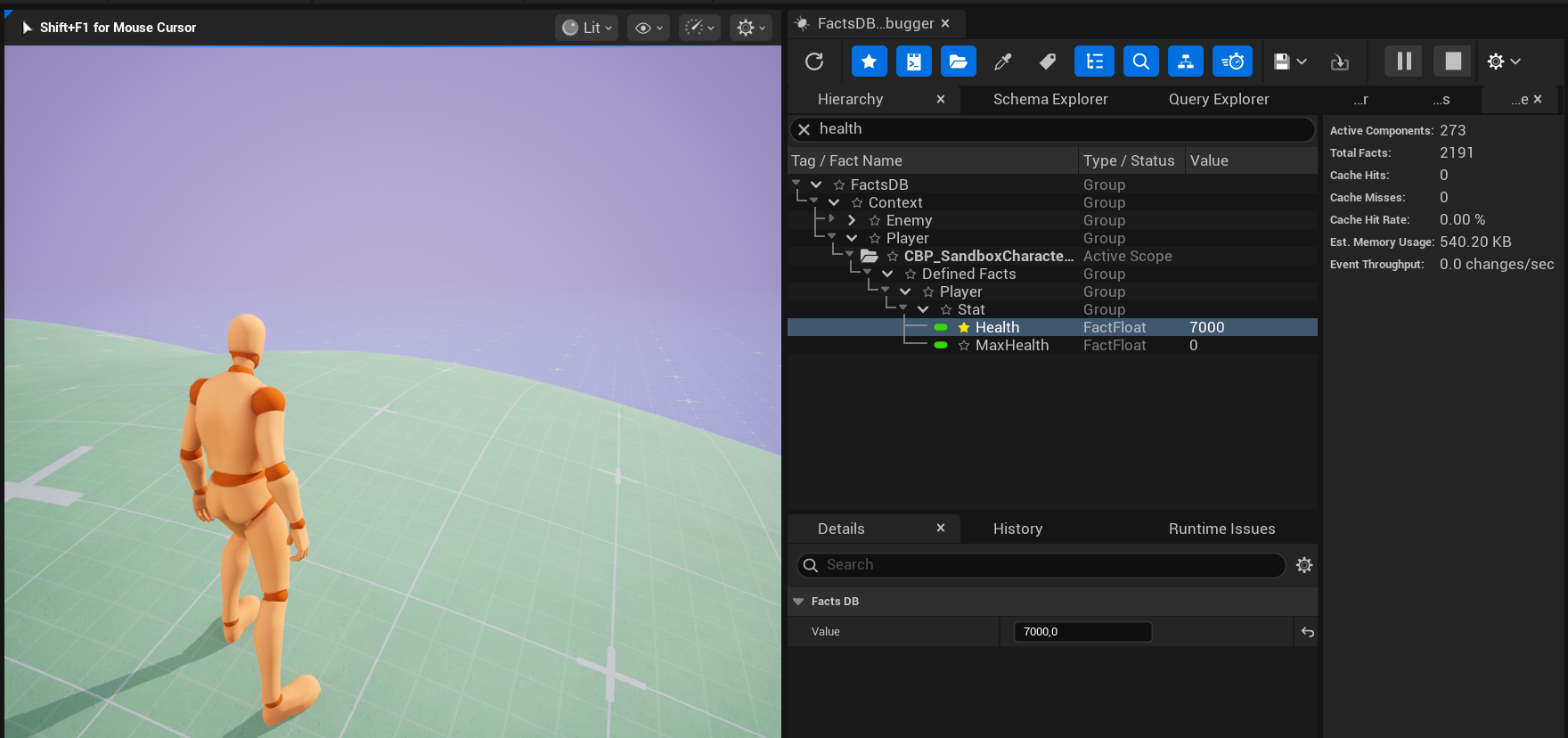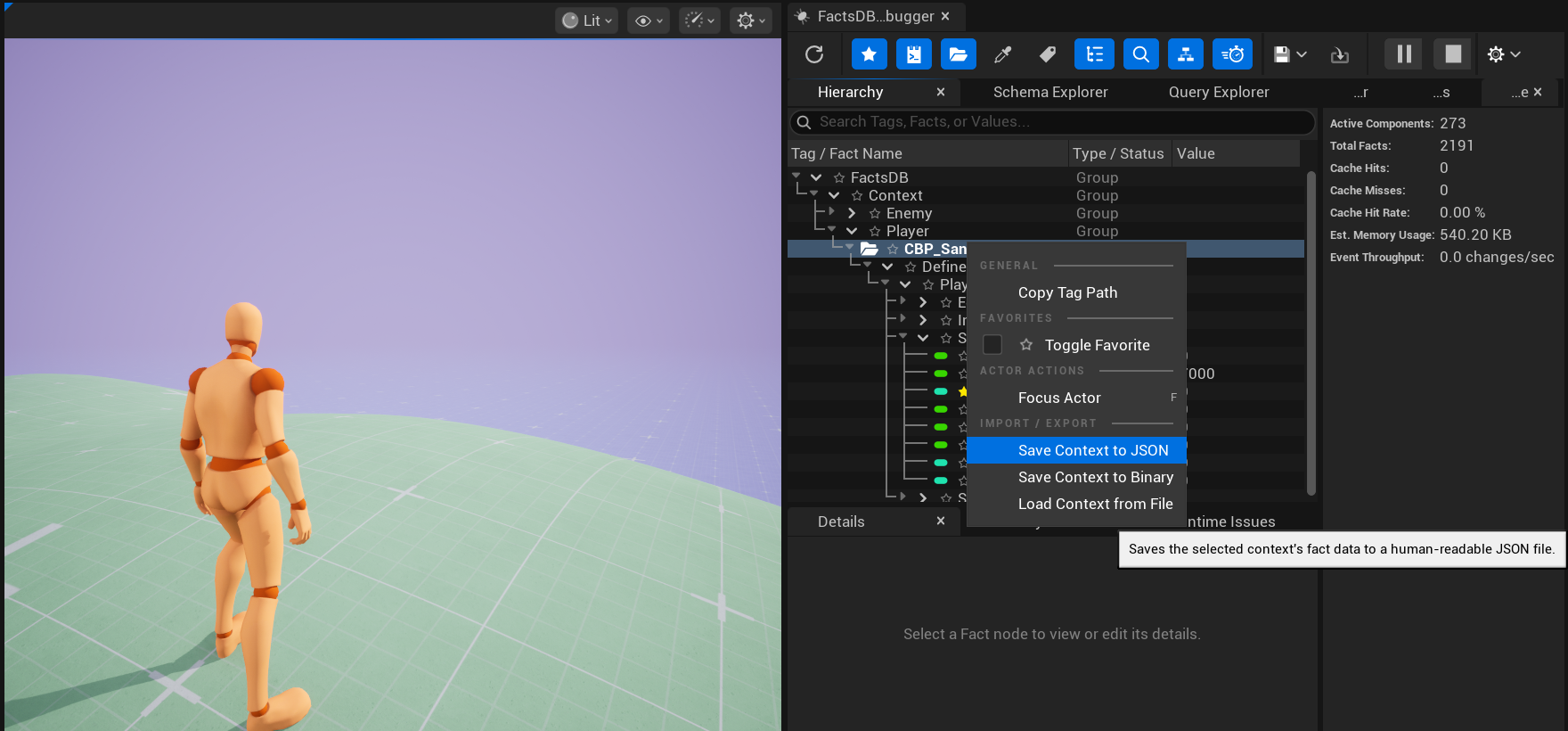Inspecting Data: Hierarchy & Details
The Hierarchy and Details panels are the primary tools you'll use for inspecting and interacting with your game's state in real-time.
The Hierarchy View
This panel is your main window into the world of FactsDB. It provides a structured view of all Schemas or live Contexts.
Browsing the Tree
- Search Bar: At the top of the panel, the search bar allows you to quickly filter the entire tree. You can search by Context name, Actor name, Fact tag, or even the current value of a Fact.
- Expansion: Use the expander arrows (
>/v) to drill down into a Context and see the Facts it contains. - Hierarchical vs. Flat View: Use the toolbar button to toggle the display.
- Hierarchical (Default): Facts are organized into "folders" based on their Gameplay Tag structure (e.g.,
Fact.Player.Stat.Healthappears inside aStatfolder, which is inside aPlayerfolder). This is excellent for browsing and discovery. - Flat: All facts for a context are shown in a simple, non-nested list. This can be useful for quickly scanning all values in a small schema.
- Hierarchical (Default): Facts are organized into "folders" based on their Gameplay Tag structure (e.g.,
Understanding the Columns
- Name: Displays the name of the node.
- For a Scope, it shows the owning Actor's label and the Context ID.
- For a Fact, it shows the last part of its Gameplay Tag (e.g.,
Health). - Tooltip: Hover over any name to see its full, unique identifier (the full Context ID or Fact Tag).
- Type / Status: Shows the data type of the Fact (e.g.,
FactFloat,FactBool, or your custom struct name). - Value: Shows a condensed, human-readable representation of the Fact's current value.
Iconography and Indicators
The Hierarchy View uses several icons to give you information at a glance:
| Icon | Meaning | Description |
|---|---|---|
| Folder Icon | Scope / Context | Represents a live runtime Context, usually labeled with its owning Actor. |
| Pill Icon | Fact | Represents an individual Fact. The color of the pill matches its Blueprint data type. |
| Star Icon | Favorite | Indicates that this node has been marked as a favorite. Click the star icon to toggle this. |
| Lock Icon | Read-Only | This Fact is defined as bIsReadOnly in its Schema and cannot be modified at runtime. |
| Link Icon | Inherited | This Fact is not defined directly in the Context's Schema, but is inherited from a parent Schema. Hover for details. |
| Italic Text | Default Value | A Fact's name will appear in italics if its current value is still the default value loaded from its Schema. Once modified, the text becomes regular. |
The Details Panel
When you select a Fact node in the Hierarchy view, the Details panel comes to life.
Inspecting Values
The panel displays the Fact's Value property in a standard Unreal property editor. This allows you to inspect all fields of complex structs, check vector components, or see the precise value of a float.
Live Editing during PIE
This is one of the debugger's most powerful features.
- Start a PIE session.
- Select a Fact in the Hierarchy view.
- In the Details panel, simply change its value.
The change is instantly pushed into the game. This allows for incredibly fast iteration and balancing. You can tweak a character's speed, damage, or health in real-time without stopping the game, recompiling, or restarting.

Live editing is only possible under these conditions:
- You must be in a Play-In-Editor (PIE) or Simulate-In-Editor (SIE) session.
- You must have network authority over the Actor that owns the
UFactsComponent. In a typical client-server setup, this means you can only edit values on the server. - The Fact itself must not be marked as
bIsReadOnlyin itsFFactDefinition. The Details panel will show a warning banner if editing is disabled for any of these reasons.
Context Menu
Right-clicking on a node in the Hierarchy view opens a context menu with useful shortcuts. The available actions adapt to the type of node selected, providing relevant tools for both individual Facts and live runtime Contexts.
For a Fact node:
- Toggle Favorite: Adds or removes the fact from the favorites list for quick access.
- Copy Tag Path: Copies the full
FFactTag(e.g.,Facts.Character.Stats.Health) to the clipboard. - Open Source DataTable: Jumps directly to the
UDataTableasset and the specific row where this fact's default value and properties are defined. This action is invaluable for tracing data origins. - Focus Actor: (Available only on facts within a runtime context) Selects the owning Actor of the context in the main level viewport and focuses the camera on it.

For a runtime Context node:
-
Focus Actor: Selects the owning Actor of this context in the main level viewport and focuses the camera on it.
-
Toggle Favorite: Adds or removes the entire context node from the favorites list.
-
Copy Context ID: Copies the full, unique
FFactContextIDstring (e.g.,Context.Enemy.Goblin[Goblin_Instance_42]) to the clipboard. -
Save/Load Context: Provides options to serialize the context's current state to a JSON or binary file, and to load a previously saved state back into the live context. This is a powerful feature for debugging specific scenarios and for save/load testing.
Next Up: The Query Explorer